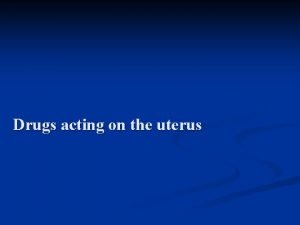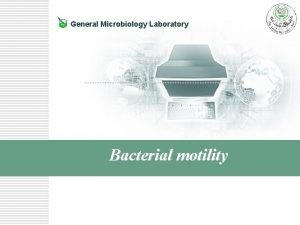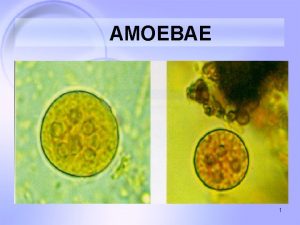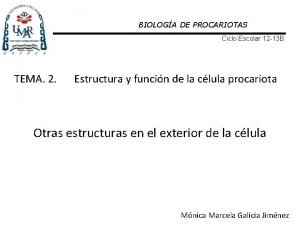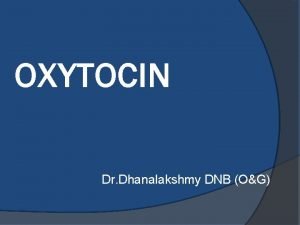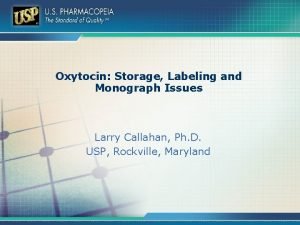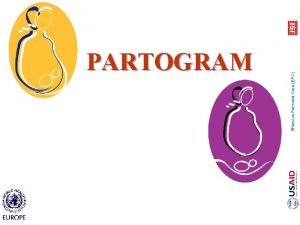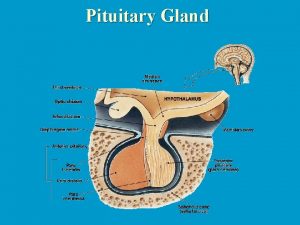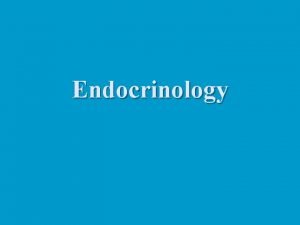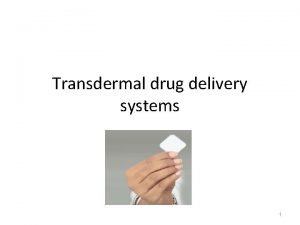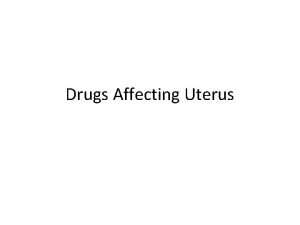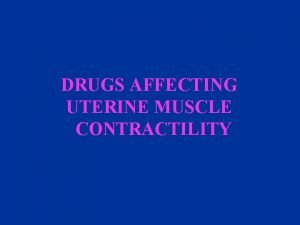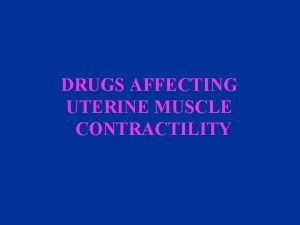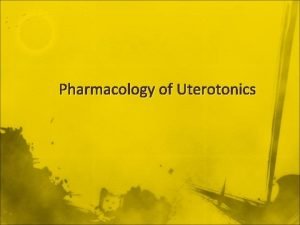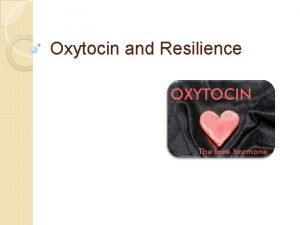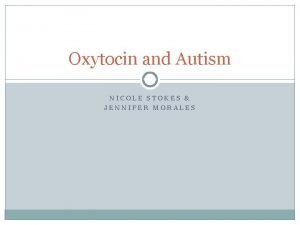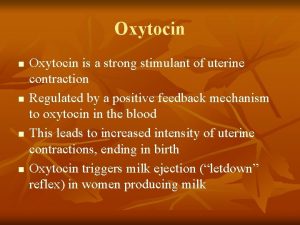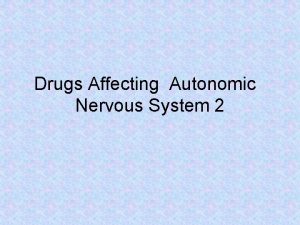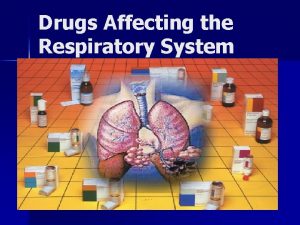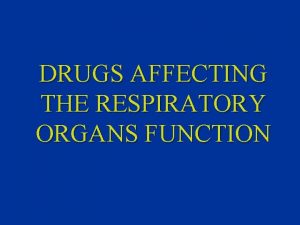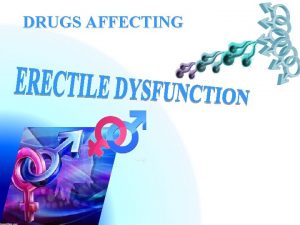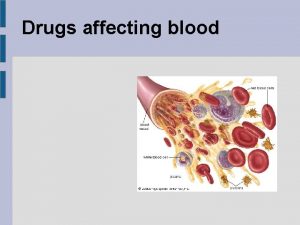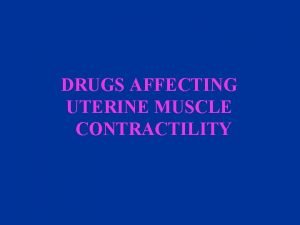Chapter 5 Drugs affecting the uterine motility Oxytocin





















- Slides: 21

Chapter 5: Drugs affecting the uterine motility Oxytocin, prostaglandins, ergot alkaloids

Drugs acting on uterine motility Uterine stimulants Uterine relaxants (Tocolytics) § Beta sympathomimetics ü Terbutaline, Ritodrine § Ergot alkaloids: § Calcium channel blockers ü Ergometrine, methylergometrine ü Nifedipine § Prostaglandins: § Magnesium sulphate § Prostaglandin inhibiting agents ü PGE 2, PGF 2α ü Indomethacin § Miscellaneous: § Oxytocin antagonist ü Ethacridine, quinine ü Atosiban § Oxytocin

Role of oxytocin in uterine contraction during labor cervix,

Role of oxytocin in uterine contraction during labor § The hormone oxytocin regulates myometrial activity, causing uterine contraction. § Baby pushes against cervix, causing it to stretch which causes nerve impulses to be sent to brain hypothalamus. § Oxytocin is released from fetus and mother’s posterior pituitary. § This oxytocin stimulates contraction of uterus. Uterine contraction further stimulates release of more oxytocin from pituitary gland. § Oxytocin also stimulates placenta to make prostaglandins which further cause contraction of the uterus. § Given by slow intravenous infusion to induce labor, oxytocin causes regular coordinated contractions that travel from fundus to cervix.

Role of oxytocin in lactation § Suckling of baby stimulate hypothalamus to release of oxytocin from posterior pituitary and prolactin from anterior pituitary. § Prolactin acts on milk-making tissue to produce milk for baby. § Oxytocin contracts myoepithelial cells in the mammary gland, which causes ‘milk let-down’- the expression of milk from the alveoli and ducts. § Oxytocin also makes the milk ducts widen, making it easier for the milk to flow down.


Inducing labor § Inducing labor is the artificial start of the birth process through medical interventions or other methods. § According to the American College of Obstetricians and Gynecologists, labor should be induced only when it is more risky for the baby to remain inside the mother’s uterus than to be born

Medical reasons for induction of labor § Postterm pregnancy, i. e. if the pregnancy has gone past the end of the 42 nd week § Twin pregnancy continuing beyond 38 weeks. § Premature rupture of the membranes (PROM); this is when the membranes have ruptured, but labor does not start within a specific amount of time § Previous health conditions that puts risk on the woman and/or her child such as diabetes, high blood pressure. § Intrauterine fetal growth restriction (IUGR) § There are health risks to the woman in continuing the pregnancy (pre-eclampsia) § Premature termination of the pregnancy (abortion) § Fetal death in utero and previous history of stillbirth

Labor induction methods 1. Medications § Prostaglandin: Suppositories are inserted into the vagina during the evening causing the uterus to go into labor by morning. One advantage to this method is that the mother is free to move around the labor room. § Oxytocin: The body naturally produces the hormone oxytocin to stimulate contractions. Oxytocin can be given through an IV at low doses to stimulate contractions.

Labor induction methods 2. Artificial rupture of the membranes (AROM) § Some health care providers might suggest rupturing the amniotic membrane artificially. § When the bag of water (amniotic sac) breaks or ruptures, production of prostaglandin increases, speeding up contractions. § A sterile, plastic, thin hook is brushed against the membranes just inside the cervix causing the baby’s head to move down against the cervix, which usually causes the contractions to become stronger. This procedure releases a gush of warm amniotic fluid from the vagina.

Labor induction methods 3. Natural: § Nipple Stimulation is a natural form of labor induction that can be done manually or with an electric breastfeeding pump. § Nipple stimulation induces the production of the hormone oxytocin which causes uterine contractions. § The concept is the same as when a baby nurses right after birth, stimulating contractions, which slows bleeding.

Prostaglandins in uterine motility § The endometrium and myometrium have substantial prostaglandin-synthesising capacity, particularly in the second, proliferative phase of the menstrual cycle. § Prostaglandin F 2α (PGF 2α) is generated in large amounts, and has been implicated in the ischaemic necrosis of the endometrium that precedes menstruation. § PGE 2 and PGI 2 are also generated by the uterus. § PGF 2α and PGE 2 promote coordinated contractions of the body of the pregnant uterus, while relaxing cervix. § Prostaglandins used in obstetrics: ü Dinoprostone (PGE 2) ü Carboprost (PGF 2 a) ü Gemeprost or misoprostol (PGE 1 analogues)

Preterm labor § A normal pregnancy lasts about 40 weeks. Occasionally, labor begins prematurely, before the 37 th week of pregnancy. This happens because uterine contractions cause the cervix to open earlier than normal. Consequently, the baby is born premature and can be at risk for health problem. § The earlier premature birth happens, the greater the health risks for the baby. § Many premature babies might suffer from long-term mental and physical disabilities. That’s why they need special care in the neonatal intensive care unit. § The specific cause of preterm labor often isn't clear. However, certain risk factors might increase the risk, but preterm labor can also occur in pregnant women with no known risk factors.

Preterm labor Sign and Symptoms § Constant low, dull backache § Mild abdominal cramps § Vaginal spotting or light bleeding § Preterm rupture of membranes § A sensation of pelvic or lower abdominal pressure § Regular or frequent sensations of abdominal tightening (contractions) § A change in type of vaginal discharge — watery, mucus-like or bloody

Preterm Labor: Risk Factors § § § Smoking cigarettes or using illicit drugs Presence of a fetal birth defect Too much amniotic fluid (polyhydramnios) Vaginal bleeding during pregnancy Stressful life events, such as the death of a loved one An interval of less than six months between pregnancies Previous preterm labor or premature birth Pregnancy with twins, triplets or other multiples Problems with the uterus, cervix or placenta Certain infections, particularly of the amniotic fluid and lower genital tract Some chronic conditions, such as high blood pressure and diabetes

Preterm labor Medications § Once a pregnant woman is in labor, there are no medications or surgical procedures to stop labor. § However, the doctor might recommend the following medications: Tocolytics § Tocolytics might be given to temporarily stop uterine contractions. § However, these medications won't halt preterm labor for longer than two days because they don't address the underlying cause of preterm labor. § Tocolytics might delay preterm labor long enough for corticosteroids to provide the maximum benefit or, if necessary, for patient to be transported to a facility that can provide specialized care for the premature baby.

Tocholytics § Magnesium sulphate § Prostaglandin inhibiting agents o Indomethacin § Oxytocin antagonist: Atosiban § Beta sympathomimetics o Terbutaline , Ritodrine § Calcium channel blockers: Nifedipine

Mechanism of action of tocholytic drugs § The elevation of cellular Ca 2+ promotes contraction via the Ca 2+/calmodulindependent activation of myosin light chain kinase (MLCK). § Relaxation is promoted by the elevation of cyclic nucleotides (c. AMP and c. GMP) and their activation of protein kinases, which cause phosphorylation/inactivation of MLCK. § Pharmacological manipulations to reduce myometrial contraction include: o Inhibiting Ca+2 entry (Ca 2+ channel blockers, Mg. SO 4) o Reducing mobilization of intracellular Ca 2+ by - antagonizing GPCR-mediated activation of Gq-PLC-IP 3 -Ca 2+ pathway - reducing production of the PGF 2α (with COX inhibitors) - antagonizing prostaglandin and oxytocin receptors o Enhancing relaxation by elevating cellular c. AMP (with β 2 adrenergic agonists enhancing Gs-AC) and cyclic GMP (with NO donors that stimulate guanylyl cyclase)

Mechanism of action of tocholytic drugs 2 1 3 4 6 5

Treatment of preterm labor Magnesium sulfate as tocolytics in preterm § Magnesium sulfate might be prescribed if the woman has a high risk of delivering baby between 24 and 32 weeks of pregnancy. § In the United States, IV magnesium sulfate has become the most commonly used drug for treating preterm labor. § Some research has shown that magnesium sulfate therapy might reduce the risk of a specific type of damage to the brain (cerebral palsy) for babies born before 32 weeks of gestation. § Magnesium sulfate is thought to trigger cerebral vasodilation, thus reducing ischemia generated by cerebral vasospasm during an eclamptic event.

 Uterine stimulants and relaxants
Uterine stimulants and relaxants Gray opalescent sperm
Gray opalescent sperm Motility vs mobility
Motility vs mobility Motility test positive and negative
Motility test positive and negative Motility agar test
Motility agar test Cutaneous amebiasis
Cutaneous amebiasis Stately motility
Stately motility Tsi
Tsi Gliding motility
Gliding motility Hanging drop method for motility
Hanging drop method for motility Ptocin
Ptocin Oxytocin storage
Oxytocin storage Hypertonic vs hypotonic uterine dysfunction
Hypertonic vs hypotonic uterine dysfunction Slidetodoc
Slidetodoc Oxytocin
Oxytocin Oxytocin action
Oxytocin action Tocolytic drugs
Tocolytic drugs Oxytocin
Oxytocin Oxytocin
Oxytocin Ceolocant
Ceolocant Oxytocin is secreted by
Oxytocin is secreted by Factors affecting dermal penetration of drugs
Factors affecting dermal penetration of drugs
